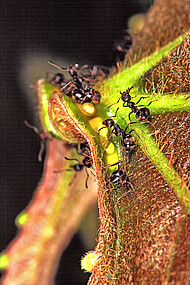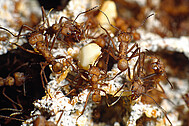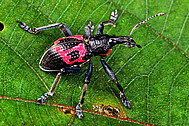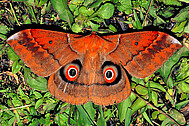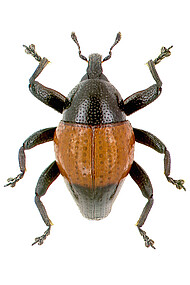Research conducted at natural history museums mainly deals with biodiversity research, i.e. taxonomy, faunistics, biogeography and evolution, based on field sampling and/or collections. The focus of most studies is on identifying species and describing and analysing animal assemblages or communities.
Research foci of the Entomology section are determined by the curators, the collections, and the overall research emphasis of the department. Due to the limitations of the museum's budget, projects are often funded by federal grants, by the state, or by private foundations.
Taxonomy, Systematics and Faunistics of Lepidoptera
Selected taxa of Geometrid moths are studied by means of systematic revisions which include descriptions of new taxa and phylogenetic analyses. The geographical focus is on Central- and Southern Europe as well as the Middle East. The faunistics of Central Europe are studied on an ongoing basis and lead to concepts for protecting the habitats and communities of butterflies. The biology and ecology of butterflies from various families is also an area of interest.
Diversity, Ecology and Taxonomy of Hymenoptera
The diversity, ecology and distribution of Hymenoptera (especially ants) are studied, especially for the regions of South America and Europe. We research the interactions of ants with other animals and plants, i.e. fungus-breeding ants (Attini) and army ants (Ecitoninae). We describe new species on a regular basis, especially of the soil fauna.
Taxonomy, Systematics and Ecology of beetles (Coleoptera)
Selected groups of litter-dwelling beetles are studied, especially weevils (Curculionoidea). We explore techniques to accelerate the discovery and description of new species. Morphological key-characters that may have led to the evolution of hyperdiverse groups are investigated. Distribution patterns in Southeast Asia and the Western Pacific are recorded and analysed.
Bodenzoologie
Untersuchungen zur Diversität und Funktion von Bodenlebewesen unter ökosystemaren Aspekten, Evaluierung der bodenbiologischen Zustände (Standortklassifikation) und die Entwicklung von regional gültigen Kriterien zum Schutz der Diversität der Bodenlebewesen und der Bodenfunktionen. Entwicklung von Kriterien für nachhaltige Nutzungsformen von Agrar- und Forstflächen.
Gemeinsamer Forschungsschwerpunkt der Zoologie und Entomologie
Biodiversity and ecology of forest-ecosystems
Species communities and their interactions in the forests of Central Europe and the tropics are studied and compared. This covers the respective geological, pedological and climatic conditions (e.g. nutrient flows, animal-plant-interactions, seed-dispersal, etc.)
Joint research focus of entomology, zoology and botany sections.
Databasing of biodiversity information
Relational databases are assembled for relevant data of organisms: records mainly resort to collection specimens or specimens obtained during the field work. In collaboration with other institutions complex online databases are established (e.g. database “Lepidoptera of Baden-Württemberg”, Global informations system Geometridae, type specimens of German collections, GBIF). Our collections are recorded in databases, especially Lepidoptera, ants, and soil biology.
Joint research focus of entomology, zoology and botany sections, often in collaboration with the Natural History Museum of Stuttgart.




